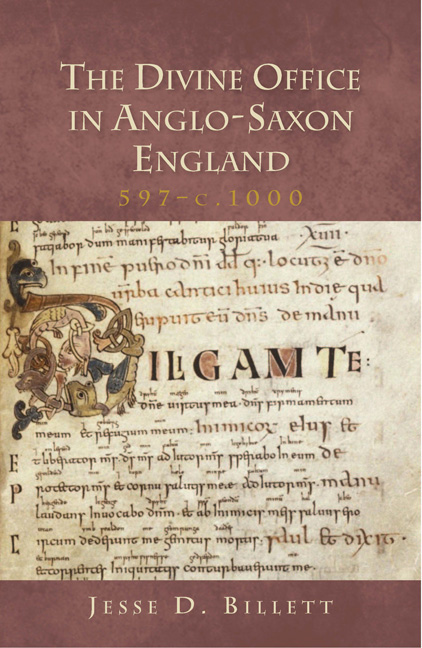Book contents
- Frontmatter
- Dedication
- Contents
- TABLES
- ILLUSTRATIONS
- PREFACE
- NOTE ON USAGE
- ABBREVIATIONS
- MANUSCRIPT SIGLA
- Part I The Historical Development of the Divine Office in England to c.1000
- 1 TOWARDS A ‘NEW NARRATIVE’ OF THE HISTORY OF THE DIVINE OFFICE IN ANGLO-SAXON ENGLAND
- 2 THE DIVINE OFFICE IN THE LATIN WEST IN THE EARLY MIDDLE AGES
- 3 THE DIVINE OFFICE IN ENGLAND FROM THE AUGUSTINIAN MISSION TO THE FIRST VIKING INVASIONS, 597–c.835
- 4 THE DIVINE OFFICE IN ENGLAND FROM THE FIRST VIKING AGE TO THE ABBACY OF DUNSTAN AT GLASTONBURY, c.835–c.940
- 5 THE DIVINE OFFICE AND THE TENTH-CENTURY ENGLISH BENEDICTINE REFORM
- Part II Manuscript Evidence for English Office Chant in the Tenth Century
- Appendices
- BIBLIOGRAPHY
- INDEX OF MANUSCRIPTS
- INDEX OF LITURGICAL FORMS
- INDEX OF BIBLICAL REFERENCES AND LITURGICAL READINGS
- GENERAL INDEX
2 - THE DIVINE OFFICE IN THE LATIN WEST IN THE EARLY MIDDLE AGES
from Part I - The Historical Development of the Divine Office in England to c.1000
Published online by Cambridge University Press: 05 November 2014
- Frontmatter
- Dedication
- Contents
- TABLES
- ILLUSTRATIONS
- PREFACE
- NOTE ON USAGE
- ABBREVIATIONS
- MANUSCRIPT SIGLA
- Part I The Historical Development of the Divine Office in England to c.1000
- 1 TOWARDS A ‘NEW NARRATIVE’ OF THE HISTORY OF THE DIVINE OFFICE IN ANGLO-SAXON ENGLAND
- 2 THE DIVINE OFFICE IN THE LATIN WEST IN THE EARLY MIDDLE AGES
- 3 THE DIVINE OFFICE IN ENGLAND FROM THE AUGUSTINIAN MISSION TO THE FIRST VIKING INVASIONS, 597–c.835
- 4 THE DIVINE OFFICE IN ENGLAND FROM THE FIRST VIKING AGE TO THE ABBACY OF DUNSTAN AT GLASTONBURY, c.835–c.940
- 5 THE DIVINE OFFICE AND THE TENTH-CENTURY ENGLISH BENEDICTINE REFORM
- Part II Manuscript Evidence for English Office Chant in the Tenth Century
- Appendices
- BIBLIOGRAPHY
- INDEX OF MANUSCRIPTS
- INDEX OF LITURGICAL FORMS
- INDEX OF BIBLICAL REFERENCES AND LITURGICAL READINGS
- GENERAL INDEX
Summary
The history of the Divine Office as it was performed in Anglo-Saxon England cannot be considered in isolation from the history of the Office on the Continent. In the present chapter, a few Continental themes of special importance to the Anglo-Saxon situation are explored, beginning with a brief account of the familiar classification of the medieval Office into two typical forms, one ‘secular’ and the other ‘monastic’. This classification is inadequate to describe the liturgical situation on the Continent and in England in the early Middle Ages. Instead, the role of monastic tradition, written and unwritten, in governing Office liturgy must be considered, particularly in the Office as it was sung from an early stage in the monasteries of Rome. The origin of the system of separate forms of the Office for secular clergy and monks must be sought in the imposition of the Roman Office on the Frankish Church in the eighth century followed by the adoption by Frankish monks, beginning in the ninth century, of a different form drawn from the Regula S. Benedicti.
The typical secular and monastic forms of the Office
For the greater part of the Middle Ages in the West, the Divine Office was celebrated according to one of two fixed patterns, or cursus. One was the secular cursus, sometimes called the ‘Roman’ or ‘cathedral’ cursus (not to be confused with the ‘cathedral Office’ of late antiquity, which was something altogether different), the other the monastic cursus, also called the Benedictine cursus.
- Type
- Chapter
- Information
- The Divine Office in Anglo-Saxon England, 597-c.1000 , pp. 13 - 77Publisher: Boydell & BrewerPrint publication year: 2014



